Critical Thinking Case Study: Analyzing Nursing Practice in Healthcare
VerifiedAdded on 2020/03/16
|9
|2182
|60
Report
AI Summary
This report analyzes a critical thinking case study involving an enrolled nurse in an emergency department who administered medication to a patient without consulting a medical officer, highlighting a breach of nursing ethics and legal principles. The nurse's actions are scrutinized for failing to utilize proper critical thinking skills, adhere to safe medication practices, and maintain effective communication. The report discusses the implications of this incident, including potential health risks and violations of the Code of Professional Conduct and the Code of Ethics for nurses, such as failing to practice safely, not adhering to nursing standards, and a lack of patient trust and respect. The analysis covers relevant laws, professional development recommendations, and the importance of patient education and effective communication in healthcare. The report emphasizes the need for nurses to act professionally, follow ethical guidelines, and prioritize patient safety through collaborative practice and adherence to established standards.
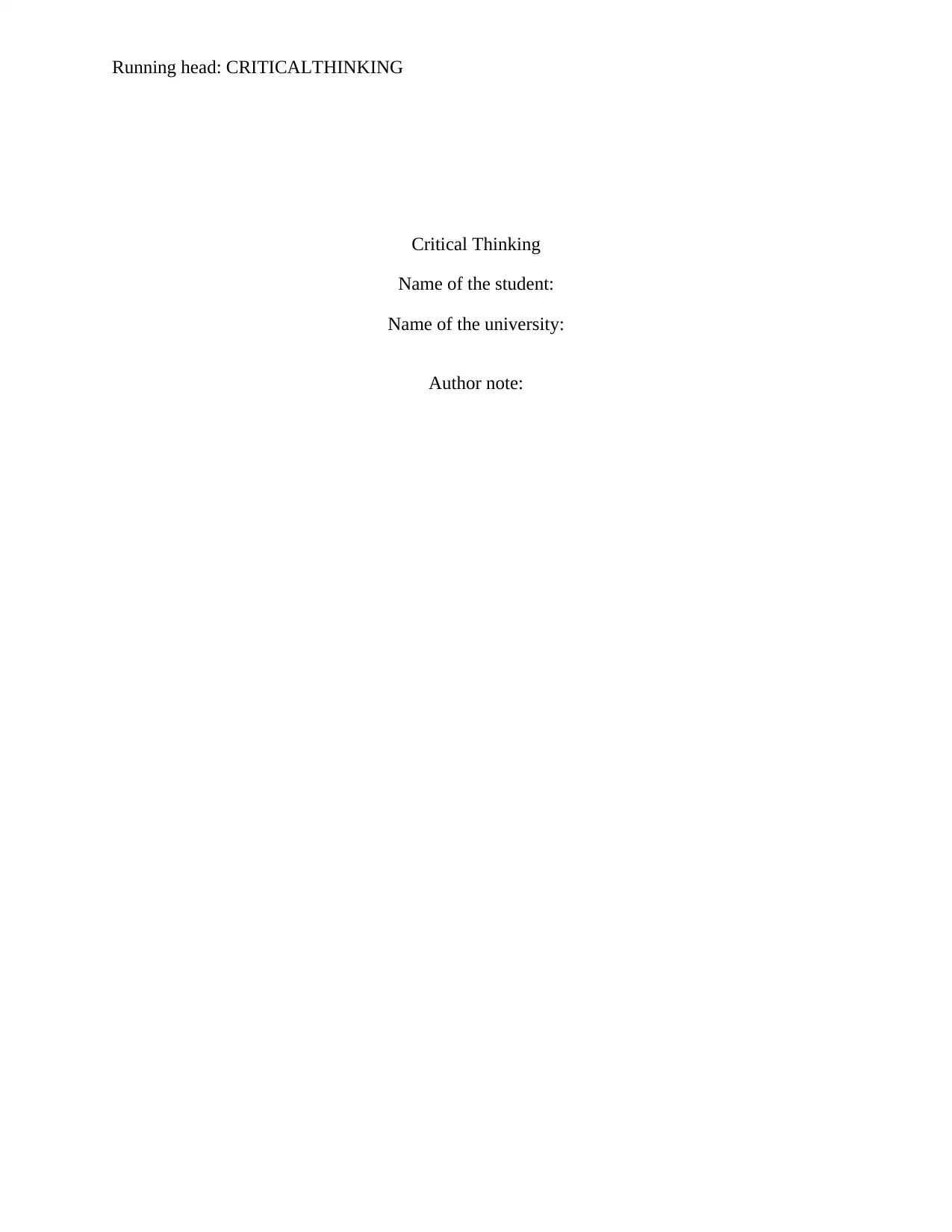
Running head: CRITICALTHINKING
Critical Thinking
Name of the student:
Name of the university:
Author note:
Critical Thinking
Name of the student:
Name of the university:
Author note:
Paraphrase This Document
Need a fresh take? Get an instant paraphrase of this document with our AI Paraphraser
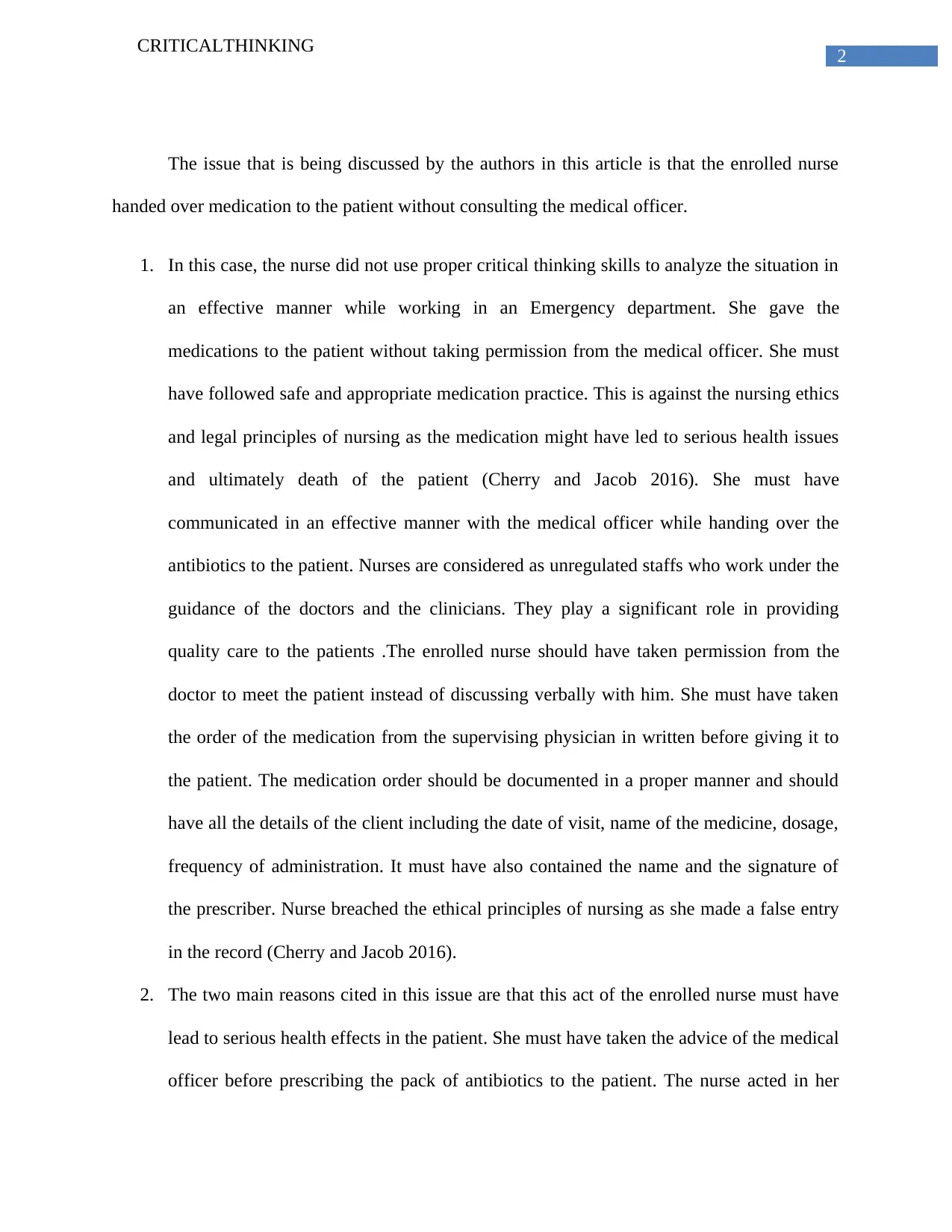
2
CRITICALTHINKING
The issue that is being discussed by the authors in this article is that the enrolled nurse
handed over medication to the patient without consulting the medical officer.
1. In this case, the nurse did not use proper critical thinking skills to analyze the situation in
an effective manner while working in an Emergency department. She gave the
medications to the patient without taking permission from the medical officer. She must
have followed safe and appropriate medication practice. This is against the nursing ethics
and legal principles of nursing as the medication might have led to serious health issues
and ultimately death of the patient (Cherry and Jacob 2016). She must have
communicated in an effective manner with the medical officer while handing over the
antibiotics to the patient. Nurses are considered as unregulated staffs who work under the
guidance of the doctors and the clinicians. They play a significant role in providing
quality care to the patients .The enrolled nurse should have taken permission from the
doctor to meet the patient instead of discussing verbally with him. She must have taken
the order of the medication from the supervising physician in written before giving it to
the patient. The medication order should be documented in a proper manner and should
have all the details of the client including the date of visit, name of the medicine, dosage,
frequency of administration. It must have also contained the name and the signature of
the prescriber. Nurse breached the ethical principles of nursing as she made a false entry
in the record (Cherry and Jacob 2016).
2. The two main reasons cited in this issue are that this act of the enrolled nurse must have
lead to serious health effects in the patient. She must have taken the advice of the medical
officer before prescribing the pack of antibiotics to the patient. The nurse acted in her
CRITICALTHINKING
The issue that is being discussed by the authors in this article is that the enrolled nurse
handed over medication to the patient without consulting the medical officer.
1. In this case, the nurse did not use proper critical thinking skills to analyze the situation in
an effective manner while working in an Emergency department. She gave the
medications to the patient without taking permission from the medical officer. She must
have followed safe and appropriate medication practice. This is against the nursing ethics
and legal principles of nursing as the medication might have led to serious health issues
and ultimately death of the patient (Cherry and Jacob 2016). She must have
communicated in an effective manner with the medical officer while handing over the
antibiotics to the patient. Nurses are considered as unregulated staffs who work under the
guidance of the doctors and the clinicians. They play a significant role in providing
quality care to the patients .The enrolled nurse should have taken permission from the
doctor to meet the patient instead of discussing verbally with him. She must have taken
the order of the medication from the supervising physician in written before giving it to
the patient. The medication order should be documented in a proper manner and should
have all the details of the client including the date of visit, name of the medicine, dosage,
frequency of administration. It must have also contained the name and the signature of
the prescriber. Nurse breached the ethical principles of nursing as she made a false entry
in the record (Cherry and Jacob 2016).
2. The two main reasons cited in this issue are that this act of the enrolled nurse must have
lead to serious health effects in the patient. She must have taken the advice of the medical
officer before prescribing the pack of antibiotics to the patient. The nurse acted in her
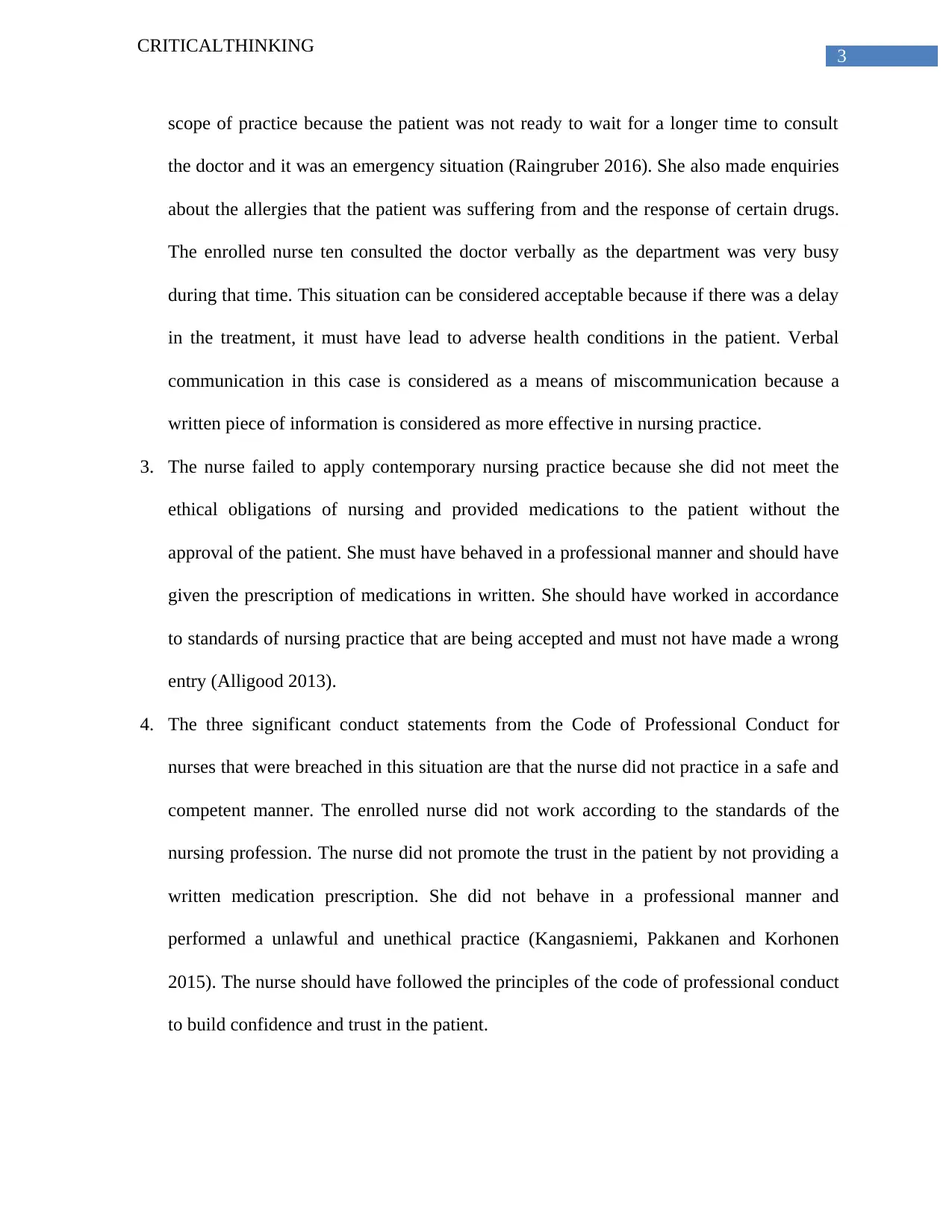
3
CRITICALTHINKING
scope of practice because the patient was not ready to wait for a longer time to consult
the doctor and it was an emergency situation (Raingruber 2016). She also made enquiries
about the allergies that the patient was suffering from and the response of certain drugs.
The enrolled nurse ten consulted the doctor verbally as the department was very busy
during that time. This situation can be considered acceptable because if there was a delay
in the treatment, it must have lead to adverse health conditions in the patient. Verbal
communication in this case is considered as a means of miscommunication because a
written piece of information is considered as more effective in nursing practice.
3. The nurse failed to apply contemporary nursing practice because she did not meet the
ethical obligations of nursing and provided medications to the patient without the
approval of the patient. She must have behaved in a professional manner and should have
given the prescription of medications in written. She should have worked in accordance
to standards of nursing practice that are being accepted and must not have made a wrong
entry (Alligood 2013).
4. The three significant conduct statements from the Code of Professional Conduct for
nurses that were breached in this situation are that the nurse did not practice in a safe and
competent manner. The enrolled nurse did not work according to the standards of the
nursing profession. The nurse did not promote the trust in the patient by not providing a
written medication prescription. She did not behave in a professional manner and
performed a unlawful and unethical practice (Kangasniemi, Pakkanen and Korhonen
2015). The nurse should have followed the principles of the code of professional conduct
to build confidence and trust in the patient.
CRITICALTHINKING
scope of practice because the patient was not ready to wait for a longer time to consult
the doctor and it was an emergency situation (Raingruber 2016). She also made enquiries
about the allergies that the patient was suffering from and the response of certain drugs.
The enrolled nurse ten consulted the doctor verbally as the department was very busy
during that time. This situation can be considered acceptable because if there was a delay
in the treatment, it must have lead to adverse health conditions in the patient. Verbal
communication in this case is considered as a means of miscommunication because a
written piece of information is considered as more effective in nursing practice.
3. The nurse failed to apply contemporary nursing practice because she did not meet the
ethical obligations of nursing and provided medications to the patient without the
approval of the patient. She must have behaved in a professional manner and should have
given the prescription of medications in written. She should have worked in accordance
to standards of nursing practice that are being accepted and must not have made a wrong
entry (Alligood 2013).
4. The three significant conduct statements from the Code of Professional Conduct for
nurses that were breached in this situation are that the nurse did not practice in a safe and
competent manner. The enrolled nurse did not work according to the standards of the
nursing profession. The nurse did not promote the trust in the patient by not providing a
written medication prescription. She did not behave in a professional manner and
performed a unlawful and unethical practice (Kangasniemi, Pakkanen and Korhonen
2015). The nurse should have followed the principles of the code of professional conduct
to build confidence and trust in the patient.
⊘ This is a preview!⊘
Do you want full access?
Subscribe today to unlock all pages.

Trusted by 1+ million students worldwide
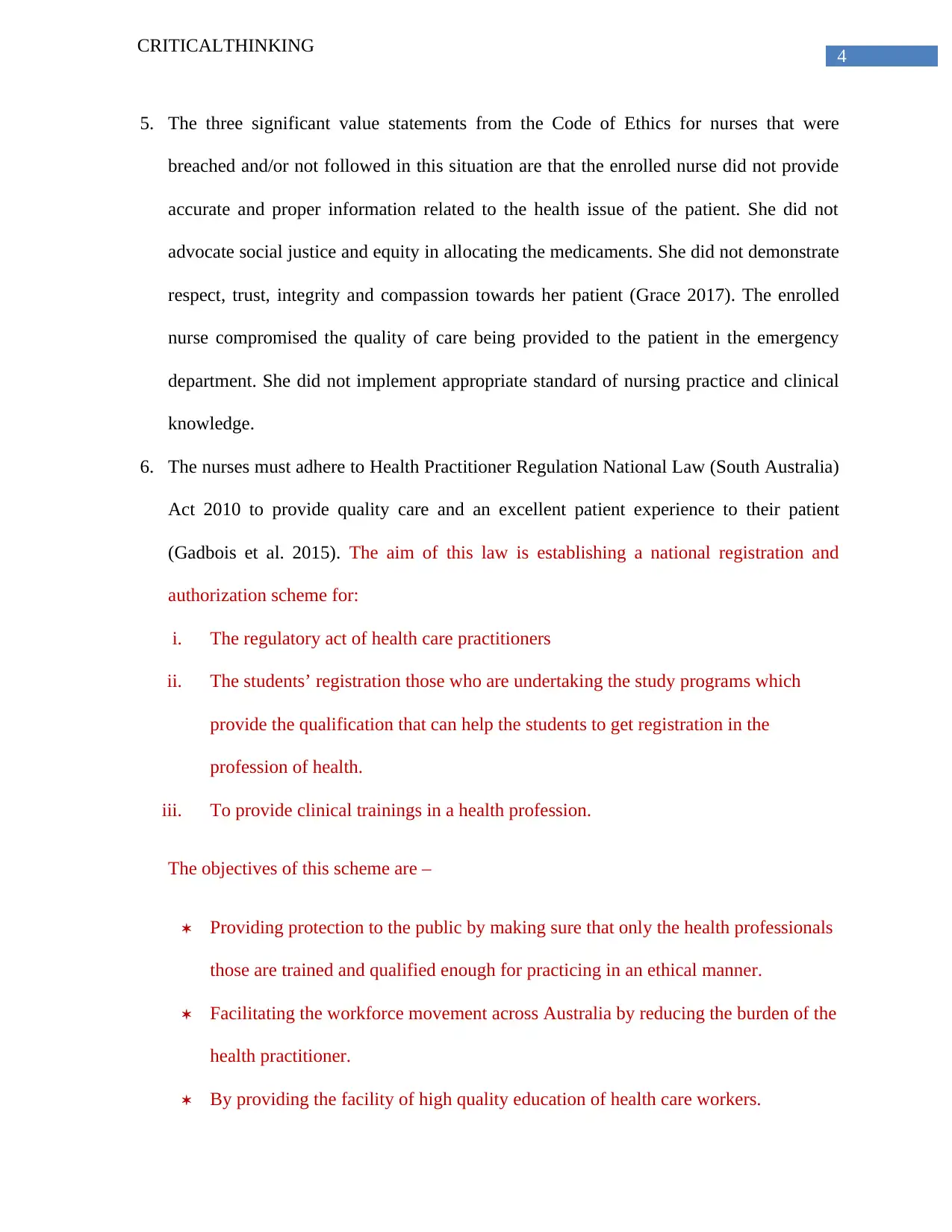
4
CRITICALTHINKING
5. The three significant value statements from the Code of Ethics for nurses that were
breached and/or not followed in this situation are that the enrolled nurse did not provide
accurate and proper information related to the health issue of the patient. She did not
advocate social justice and equity in allocating the medicaments. She did not demonstrate
respect, trust, integrity and compassion towards her patient (Grace 2017). The enrolled
nurse compromised the quality of care being provided to the patient in the emergency
department. She did not implement appropriate standard of nursing practice and clinical
knowledge.
6. The nurses must adhere to Health Practitioner Regulation National Law (South Australia)
Act 2010 to provide quality care and an excellent patient experience to their patient
(Gadbois et al. 2015). The aim of this law is establishing a national registration and
authorization scheme for:
i. The regulatory act of health care practitioners
ii. The students’ registration those who are undertaking the study programs which
provide the qualification that can help the students to get registration in the
profession of health.
iii. To provide clinical trainings in a health profession.
The objectives of this scheme are –
Providing protection to the public by making sure that only the health professionals
those are trained and qualified enough for practicing in an ethical manner.
Facilitating the workforce movement across Australia by reducing the burden of the
health practitioner.
By providing the facility of high quality education of health care workers.
CRITICALTHINKING
5. The three significant value statements from the Code of Ethics for nurses that were
breached and/or not followed in this situation are that the enrolled nurse did not provide
accurate and proper information related to the health issue of the patient. She did not
advocate social justice and equity in allocating the medicaments. She did not demonstrate
respect, trust, integrity and compassion towards her patient (Grace 2017). The enrolled
nurse compromised the quality of care being provided to the patient in the emergency
department. She did not implement appropriate standard of nursing practice and clinical
knowledge.
6. The nurses must adhere to Health Practitioner Regulation National Law (South Australia)
Act 2010 to provide quality care and an excellent patient experience to their patient
(Gadbois et al. 2015). The aim of this law is establishing a national registration and
authorization scheme for:
i. The regulatory act of health care practitioners
ii. The students’ registration those who are undertaking the study programs which
provide the qualification that can help the students to get registration in the
profession of health.
iii. To provide clinical trainings in a health profession.
The objectives of this scheme are –
Providing protection to the public by making sure that only the health professionals
those are trained and qualified enough for practicing in an ethical manner.
Facilitating the workforce movement across Australia by reducing the burden of the
health practitioner.
By providing the facility of high quality education of health care workers.
Paraphrase This Document
Need a fresh take? Get an instant paraphrase of this document with our AI Paraphraser
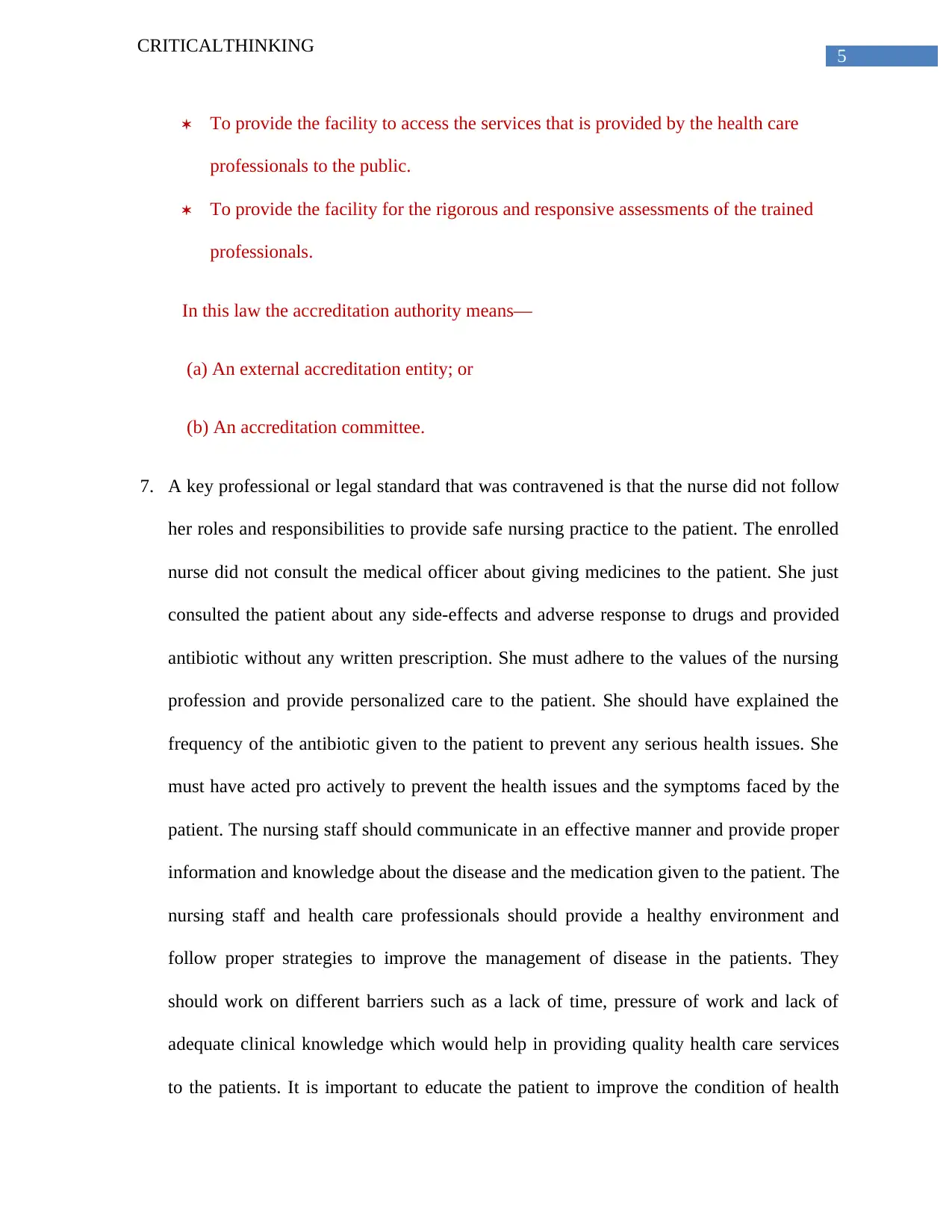
5
CRITICALTHINKING
To provide the facility to access the services that is provided by the health care
professionals to the public.
To provide the facility for the rigorous and responsive assessments of the trained
professionals.
In this law the accreditation authority means—
(a) An external accreditation entity; or
(b) An accreditation committee.
7. A key professional or legal standard that was contravened is that the nurse did not follow
her roles and responsibilities to provide safe nursing practice to the patient. The enrolled
nurse did not consult the medical officer about giving medicines to the patient. She just
consulted the patient about any side-effects and adverse response to drugs and provided
antibiotic without any written prescription. She must adhere to the values of the nursing
profession and provide personalized care to the patient. She should have explained the
frequency of the antibiotic given to the patient to prevent any serious health issues. She
must have acted pro actively to prevent the health issues and the symptoms faced by the
patient. The nursing staff should communicate in an effective manner and provide proper
information and knowledge about the disease and the medication given to the patient. The
nursing staff and health care professionals should provide a healthy environment and
follow proper strategies to improve the management of disease in the patients. They
should work on different barriers such as a lack of time, pressure of work and lack of
adequate clinical knowledge which would help in providing quality health care services
to the patients. It is important to educate the patient to improve the condition of health
CRITICALTHINKING
To provide the facility to access the services that is provided by the health care
professionals to the public.
To provide the facility for the rigorous and responsive assessments of the trained
professionals.
In this law the accreditation authority means—
(a) An external accreditation entity; or
(b) An accreditation committee.
7. A key professional or legal standard that was contravened is that the nurse did not follow
her roles and responsibilities to provide safe nursing practice to the patient. The enrolled
nurse did not consult the medical officer about giving medicines to the patient. She just
consulted the patient about any side-effects and adverse response to drugs and provided
antibiotic without any written prescription. She must adhere to the values of the nursing
profession and provide personalized care to the patient. She should have explained the
frequency of the antibiotic given to the patient to prevent any serious health issues. She
must have acted pro actively to prevent the health issues and the symptoms faced by the
patient. The nursing staff should communicate in an effective manner and provide proper
information and knowledge about the disease and the medication given to the patient. The
nursing staff and health care professionals should provide a healthy environment and
follow proper strategies to improve the management of disease in the patients. They
should work on different barriers such as a lack of time, pressure of work and lack of
adequate clinical knowledge which would help in providing quality health care services
to the patients. It is important to educate the patient to improve the condition of health
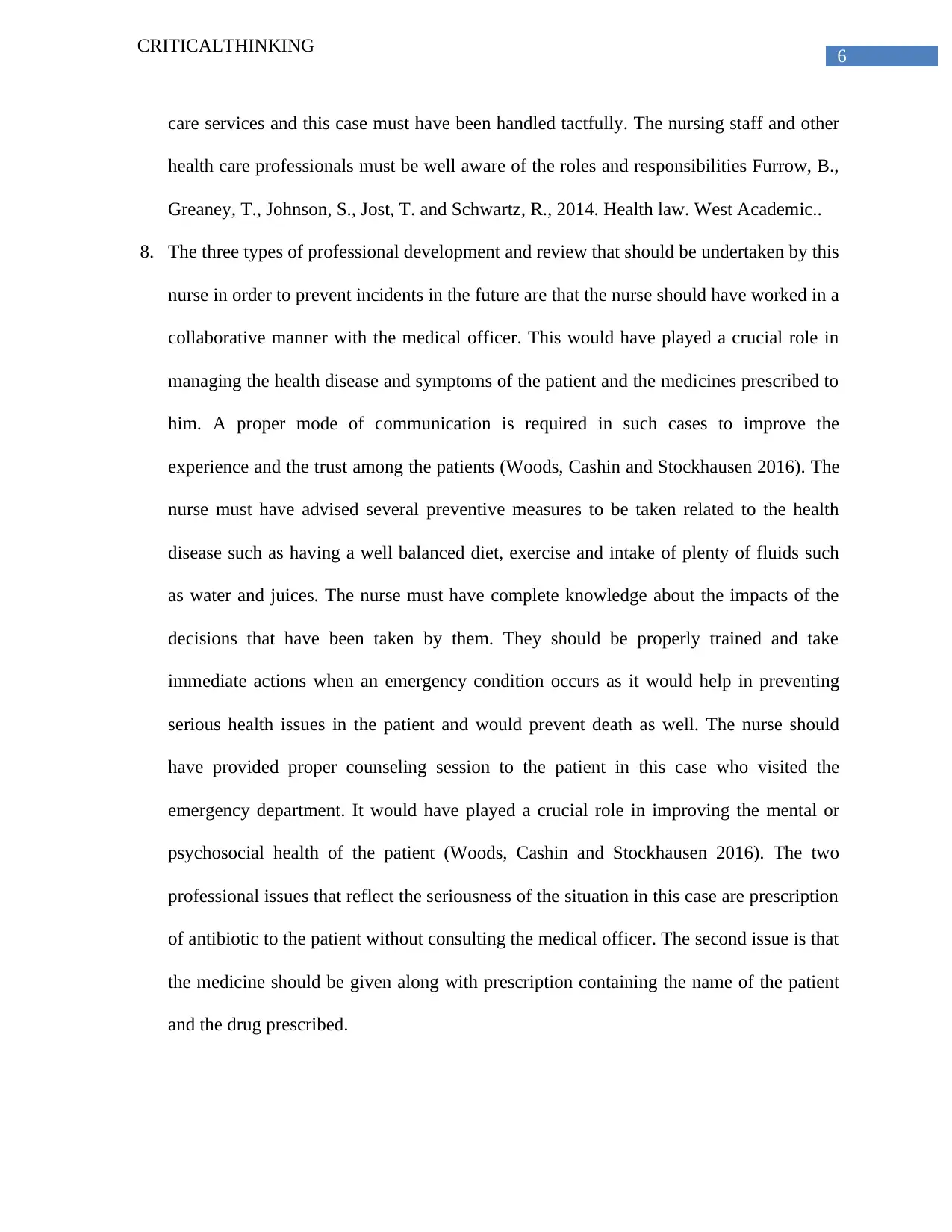
6
CRITICALTHINKING
care services and this case must have been handled tactfully. The nursing staff and other
health care professionals must be well aware of the roles and responsibilities Furrow, B.,
Greaney, T., Johnson, S., Jost, T. and Schwartz, R., 2014. Health law. West Academic..
8. The three types of professional development and review that should be undertaken by this
nurse in order to prevent incidents in the future are that the nurse should have worked in a
collaborative manner with the medical officer. This would have played a crucial role in
managing the health disease and symptoms of the patient and the medicines prescribed to
him. A proper mode of communication is required in such cases to improve the
experience and the trust among the patients (Woods, Cashin and Stockhausen 2016). The
nurse must have advised several preventive measures to be taken related to the health
disease such as having a well balanced diet, exercise and intake of plenty of fluids such
as water and juices. The nurse must have complete knowledge about the impacts of the
decisions that have been taken by them. They should be properly trained and take
immediate actions when an emergency condition occurs as it would help in preventing
serious health issues in the patient and would prevent death as well. The nurse should
have provided proper counseling session to the patient in this case who visited the
emergency department. It would have played a crucial role in improving the mental or
psychosocial health of the patient (Woods, Cashin and Stockhausen 2016). The two
professional issues that reflect the seriousness of the situation in this case are prescription
of antibiotic to the patient without consulting the medical officer. The second issue is that
the medicine should be given along with prescription containing the name of the patient
and the drug prescribed.
CRITICALTHINKING
care services and this case must have been handled tactfully. The nursing staff and other
health care professionals must be well aware of the roles and responsibilities Furrow, B.,
Greaney, T., Johnson, S., Jost, T. and Schwartz, R., 2014. Health law. West Academic..
8. The three types of professional development and review that should be undertaken by this
nurse in order to prevent incidents in the future are that the nurse should have worked in a
collaborative manner with the medical officer. This would have played a crucial role in
managing the health disease and symptoms of the patient and the medicines prescribed to
him. A proper mode of communication is required in such cases to improve the
experience and the trust among the patients (Woods, Cashin and Stockhausen 2016). The
nurse must have advised several preventive measures to be taken related to the health
disease such as having a well balanced diet, exercise and intake of plenty of fluids such
as water and juices. The nurse must have complete knowledge about the impacts of the
decisions that have been taken by them. They should be properly trained and take
immediate actions when an emergency condition occurs as it would help in preventing
serious health issues in the patient and would prevent death as well. The nurse should
have provided proper counseling session to the patient in this case who visited the
emergency department. It would have played a crucial role in improving the mental or
psychosocial health of the patient (Woods, Cashin and Stockhausen 2016). The two
professional issues that reflect the seriousness of the situation in this case are prescription
of antibiotic to the patient without consulting the medical officer. The second issue is that
the medicine should be given along with prescription containing the name of the patient
and the drug prescribed.
⊘ This is a preview!⊘
Do you want full access?
Subscribe today to unlock all pages.

Trusted by 1+ million students worldwide
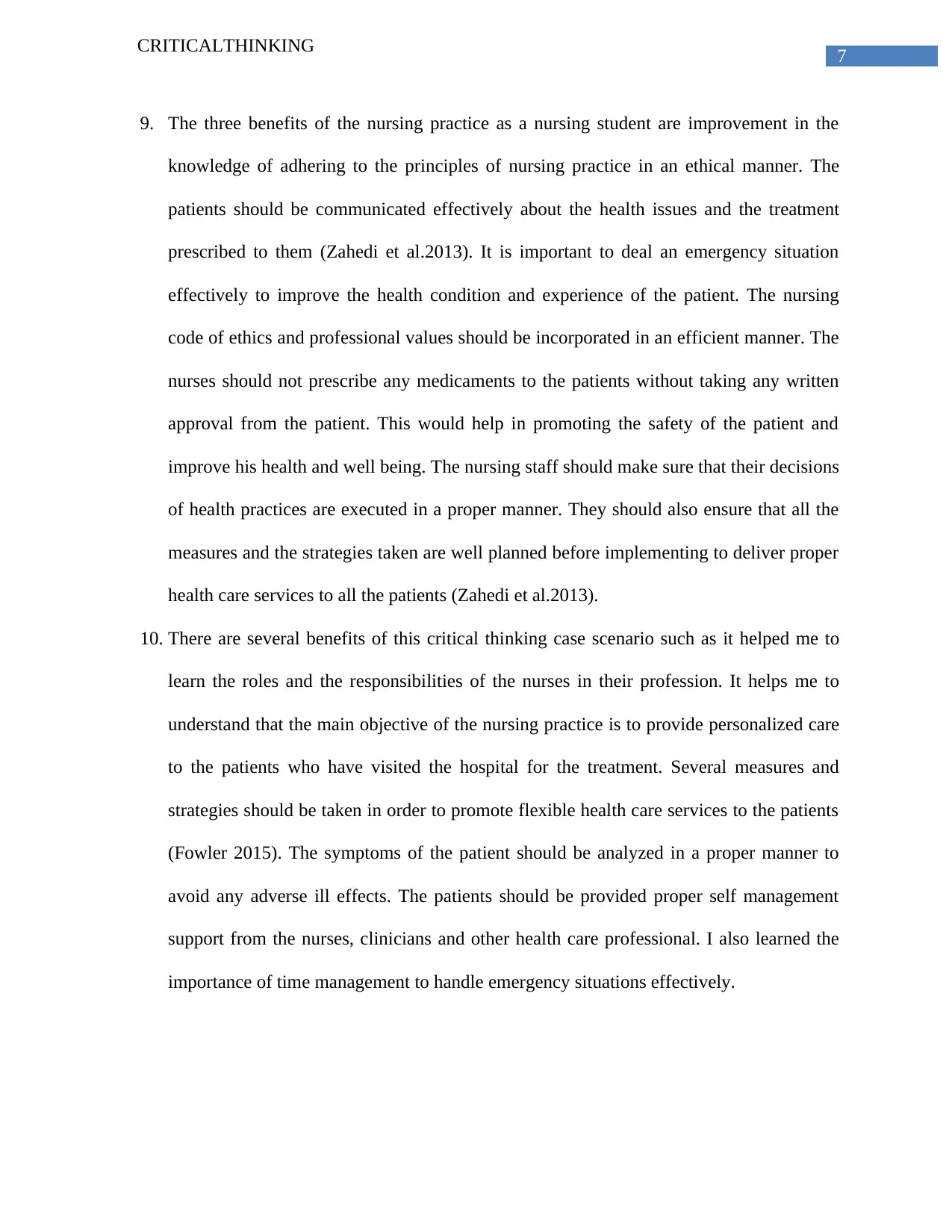
7
CRITICALTHINKING
9. The three benefits of the nursing practice as a nursing student are improvement in the
knowledge of adhering to the principles of nursing practice in an ethical manner. The
patients should be communicated effectively about the health issues and the treatment
prescribed to them (Zahedi et al.2013). It is important to deal an emergency situation
effectively to improve the health condition and experience of the patient. The nursing
code of ethics and professional values should be incorporated in an efficient manner. The
nurses should not prescribe any medicaments to the patients without taking any written
approval from the patient. This would help in promoting the safety of the patient and
improve his health and well being. The nursing staff should make sure that their decisions
of health practices are executed in a proper manner. They should also ensure that all the
measures and the strategies taken are well planned before implementing to deliver proper
health care services to all the patients (Zahedi et al.2013).
10. There are several benefits of this critical thinking case scenario such as it helped me to
learn the roles and the responsibilities of the nurses in their profession. It helps me to
understand that the main objective of the nursing practice is to provide personalized care
to the patients who have visited the hospital for the treatment. Several measures and
strategies should be taken in order to promote flexible health care services to the patients
(Fowler 2015). The symptoms of the patient should be analyzed in a proper manner to
avoid any adverse ill effects. The patients should be provided proper self management
support from the nurses, clinicians and other health care professional. I also learned the
importance of time management to handle emergency situations effectively.
CRITICALTHINKING
9. The three benefits of the nursing practice as a nursing student are improvement in the
knowledge of adhering to the principles of nursing practice in an ethical manner. The
patients should be communicated effectively about the health issues and the treatment
prescribed to them (Zahedi et al.2013). It is important to deal an emergency situation
effectively to improve the health condition and experience of the patient. The nursing
code of ethics and professional values should be incorporated in an efficient manner. The
nurses should not prescribe any medicaments to the patients without taking any written
approval from the patient. This would help in promoting the safety of the patient and
improve his health and well being. The nursing staff should make sure that their decisions
of health practices are executed in a proper manner. They should also ensure that all the
measures and the strategies taken are well planned before implementing to deliver proper
health care services to all the patients (Zahedi et al.2013).
10. There are several benefits of this critical thinking case scenario such as it helped me to
learn the roles and the responsibilities of the nurses in their profession. It helps me to
understand that the main objective of the nursing practice is to provide personalized care
to the patients who have visited the hospital for the treatment. Several measures and
strategies should be taken in order to promote flexible health care services to the patients
(Fowler 2015). The symptoms of the patient should be analyzed in a proper manner to
avoid any adverse ill effects. The patients should be provided proper self management
support from the nurses, clinicians and other health care professional. I also learned the
importance of time management to handle emergency situations effectively.
Paraphrase This Document
Need a fresh take? Get an instant paraphrase of this document with our AI Paraphraser
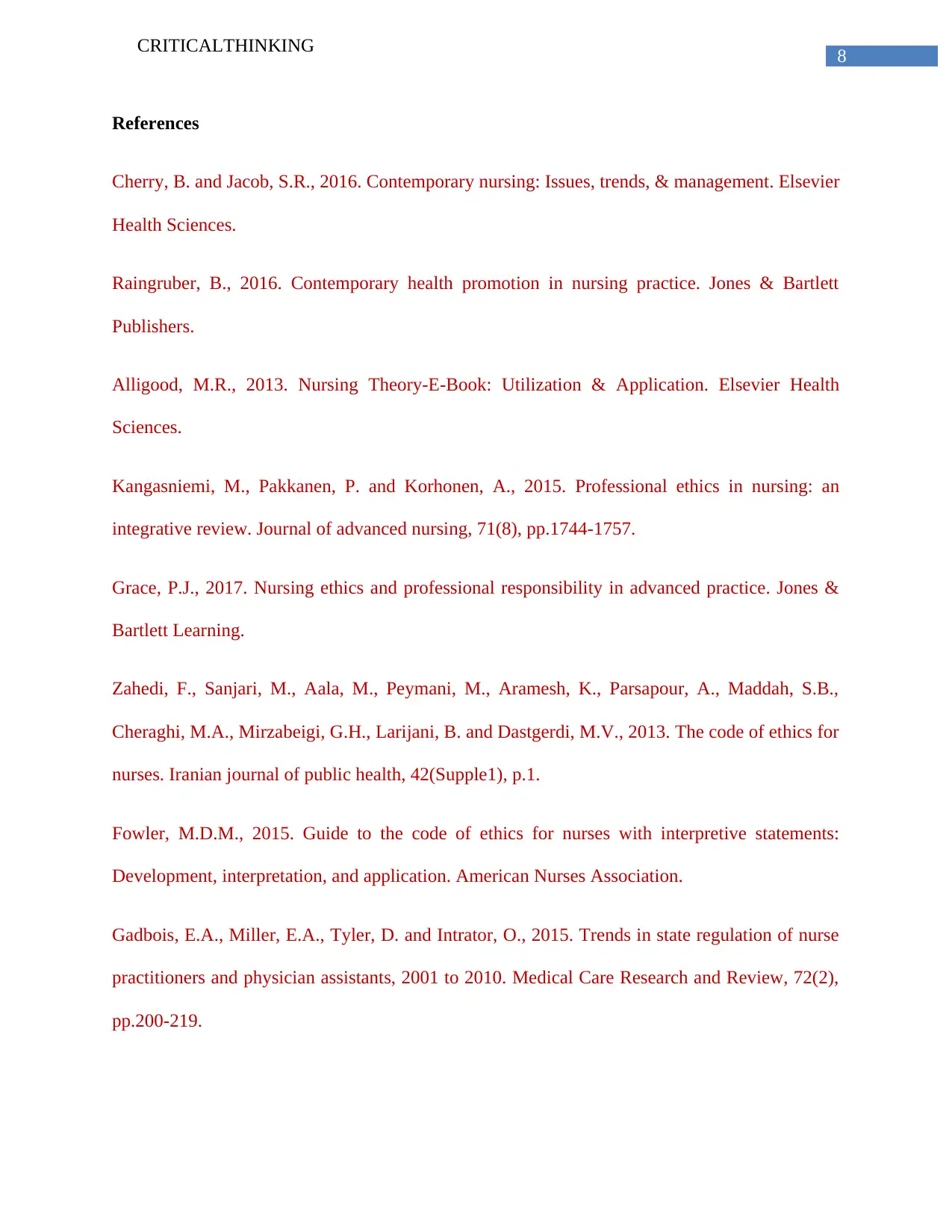
8
CRITICALTHINKING
References
Cherry, B. and Jacob, S.R., 2016. Contemporary nursing: Issues, trends, & management. Elsevier
Health Sciences.
Raingruber, B., 2016. Contemporary health promotion in nursing practice. Jones & Bartlett
Publishers.
Alligood, M.R., 2013. Nursing Theory-E-Book: Utilization & Application. Elsevier Health
Sciences.
Kangasniemi, M., Pakkanen, P. and Korhonen, A., 2015. Professional ethics in nursing: an
integrative review. Journal of advanced nursing, 71(8), pp.1744-1757.
Grace, P.J., 2017. Nursing ethics and professional responsibility in advanced practice. Jones &
Bartlett Learning.
Zahedi, F., Sanjari, M., Aala, M., Peymani, M., Aramesh, K., Parsapour, A., Maddah, S.B.,
Cheraghi, M.A., Mirzabeigi, G.H., Larijani, B. and Dastgerdi, M.V., 2013. The code of ethics for
nurses. Iranian journal of public health, 42(Supple1), p.1.
Fowler, M.D.M., 2015. Guide to the code of ethics for nurses with interpretive statements:
Development, interpretation, and application. American Nurses Association.
Gadbois, E.A., Miller, E.A., Tyler, D. and Intrator, O., 2015. Trends in state regulation of nurse
practitioners and physician assistants, 2001 to 2010. Medical Care Research and Review, 72(2),
pp.200-219.
CRITICALTHINKING
References
Cherry, B. and Jacob, S.R., 2016. Contemporary nursing: Issues, trends, & management. Elsevier
Health Sciences.
Raingruber, B., 2016. Contemporary health promotion in nursing practice. Jones & Bartlett
Publishers.
Alligood, M.R., 2013. Nursing Theory-E-Book: Utilization & Application. Elsevier Health
Sciences.
Kangasniemi, M., Pakkanen, P. and Korhonen, A., 2015. Professional ethics in nursing: an
integrative review. Journal of advanced nursing, 71(8), pp.1744-1757.
Grace, P.J., 2017. Nursing ethics and professional responsibility in advanced practice. Jones &
Bartlett Learning.
Zahedi, F., Sanjari, M., Aala, M., Peymani, M., Aramesh, K., Parsapour, A., Maddah, S.B.,
Cheraghi, M.A., Mirzabeigi, G.H., Larijani, B. and Dastgerdi, M.V., 2013. The code of ethics for
nurses. Iranian journal of public health, 42(Supple1), p.1.
Fowler, M.D.M., 2015. Guide to the code of ethics for nurses with interpretive statements:
Development, interpretation, and application. American Nurses Association.
Gadbois, E.A., Miller, E.A., Tyler, D. and Intrator, O., 2015. Trends in state regulation of nurse
practitioners and physician assistants, 2001 to 2010. Medical Care Research and Review, 72(2),
pp.200-219.
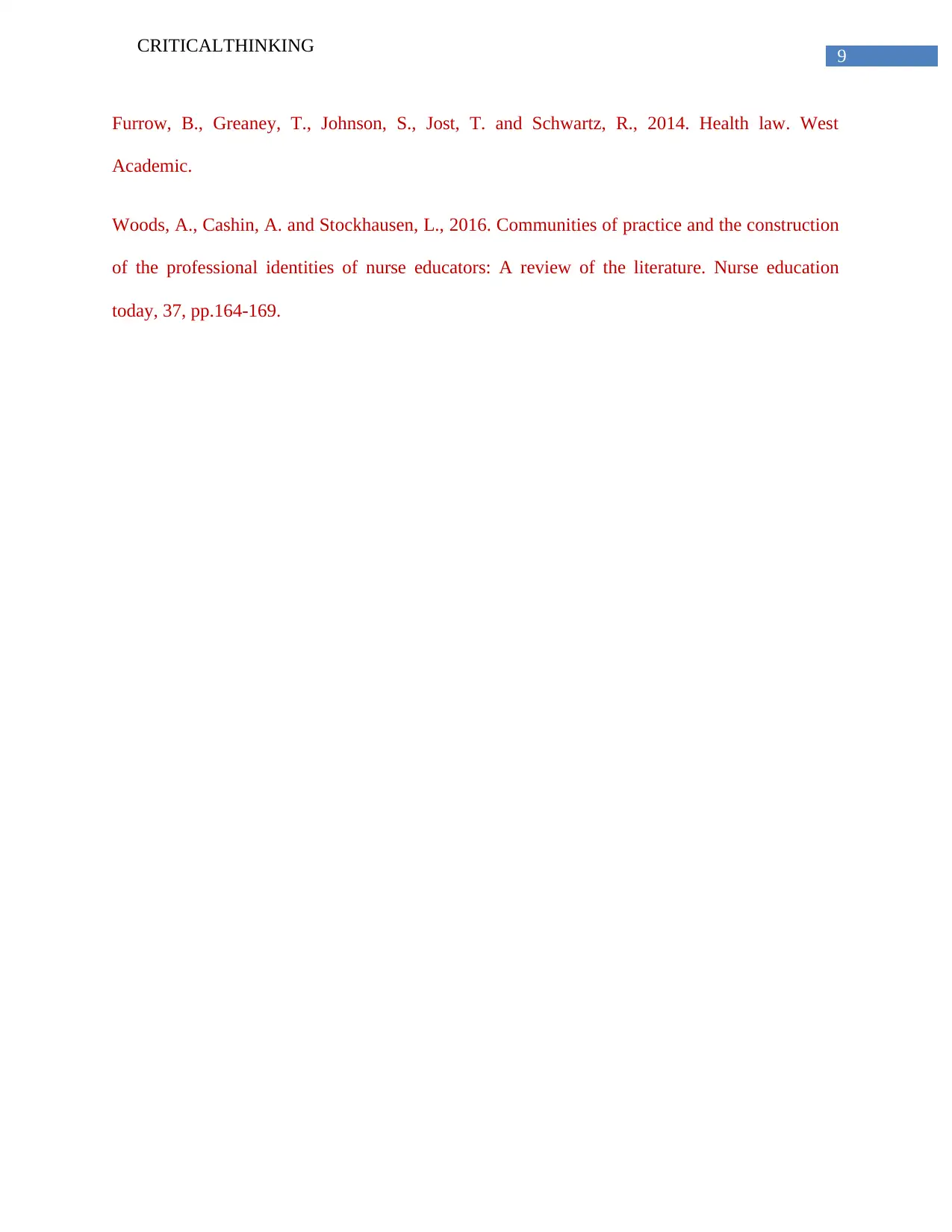
9
CRITICALTHINKING
Furrow, B., Greaney, T., Johnson, S., Jost, T. and Schwartz, R., 2014. Health law. West
Academic.
Woods, A., Cashin, A. and Stockhausen, L., 2016. Communities of practice and the construction
of the professional identities of nurse educators: A review of the literature. Nurse education
today, 37, pp.164-169.
CRITICALTHINKING
Furrow, B., Greaney, T., Johnson, S., Jost, T. and Schwartz, R., 2014. Health law. West
Academic.
Woods, A., Cashin, A. and Stockhausen, L., 2016. Communities of practice and the construction
of the professional identities of nurse educators: A review of the literature. Nurse education
today, 37, pp.164-169.
⊘ This is a preview!⊘
Do you want full access?
Subscribe today to unlock all pages.

Trusted by 1+ million students worldwide
1 out of 9
Related Documents
Your All-in-One AI-Powered Toolkit for Academic Success.
+13062052269
info@desklib.com
Available 24*7 on WhatsApp / Email
![[object Object]](/_next/static/media/star-bottom.7253800d.svg)
Unlock your academic potential
Copyright © 2020–2025 A2Z Services. All Rights Reserved. Developed and managed by ZUCOL.





